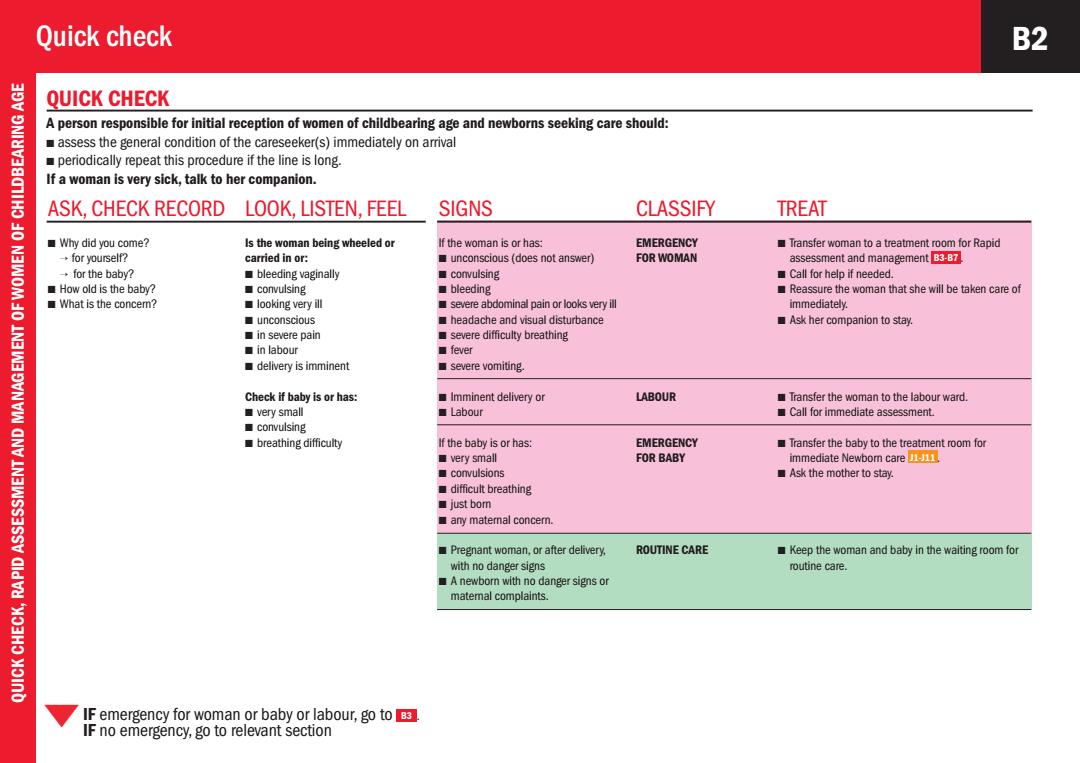正在加载图片...

Quick check B2 学 QUICK CHECK A person responsible for initial reception of women of childbearing age and newborns seeking care should: assess the general condition of the careseeker(s)immediately on arrival periodically repeat this procedure if the line is long. If a woman is very sick,talk to her companion. ASK,CHECK RECORD LOOK,LISTEN.FEEL SIGNS CLASSIFY TREAT ■Why did you come? Is the woman being wheeled or If the woman is or has: EMERGENCY Transfer woman to a treatment room for Rapid N3WOM →for yourself? carried in or: unconscious(does not answer) FOR WOMAN assessment and management B for the baby? ■bleeding vaginally ■corvulsing Call for help if needed. ■How old is the baby2 ■convulsing ■bleeding Reassure the woman that she will be taken care of 台 ■What is the concem? ■looking very ill severe abdominal pain or looks very ill immediately. ■unconscious headache and visual disturbance Ask her companion to stay. ■in severe pain severe difficulty breathing ■in labour ■fever delivery is imminent ■severe vomiting Check if baby is or has: ■Imminent delivery or LABOUR Transfer the woman to the labour ward ■very small ■Labour Call for immediate assessment ■convulsing ■breathing difficulty If the baby is or has: EMERGENCY Transfer the baby to the treatment room for ■very small FOR BABY immediate Newbom care ■convulsions ■Ask the mother to stay. ■difficult breathing ■just bom any matemal concern Pregnant woman,or after delivery. ROUTINE CARE Keep the woman and baby in the waiting room for with no danger signs routine care. A newborn with no danger signs or matemal complaints. IF emergency for woman or baby or labour,go to IF no emergency,go to relevant sectionQuick check QUICK CHECK, RAPID ASSESSMENT AND MANAGEMENT OF WOMEN OF CHILDBEARING AGE ASK, CHECK RECORD N Why did you come? ¡ for yourself? ¡ for the baby? N How old is the baby? N What is the concern? LOOK, LISTEN, FEEL Is the woman being wheeled or carried in or: N bleeding vaginally N convulsing N looking very ill N unconscious N in severe pain N in labour N delivery is imminent Check if baby is or has: N very small N convulsing N breathing difficulty SIGNS If the woman is or has: N unconscious (does not answer) N convulsing N bleeding N severe abdominal pain or looks very ill N headache and visual disturbance N severe difficulty breathing N fever N severe vomiting. N Imminent delivery or N Labour If the baby is or has: N very small N convulsions N difficult breathing N just born N any maternal concern. N Pregnant woman, or after delivery, with no danger signs N A newborn with no danger signs or maternal complaints. TREAT N Transfer woman to a treatment room for Rapid assessment and management B3-B7 . N Call for help if needed. N Reassure the woman that she will be taken care of immediately. N Ask her companion to stay. N Transfer the woman to the labour ward. N Call for immediate assessment. N Transfer the baby to the treatment room for immediate Newborn care J1-J11 . N Ask the mother to stay. N Keep the woman and baby in the waiting room for routine care. CLASSIFY EMERGENCY FOR WOMAN LABOUR EMERGENCY FOR BABY ROUTINE CARE IF emergency for woman or baby or labour, go to B3 . IF no emergency, go to relevant section QUICK CHECK A person responsible for initial reception of women of childbearing age and newborns seeking care should: N assess the general condition of the careseeker(s) immediately on arrival N periodically repeat this procedure if the line is long. If a woman is very sick, talk to her companion. B2 T